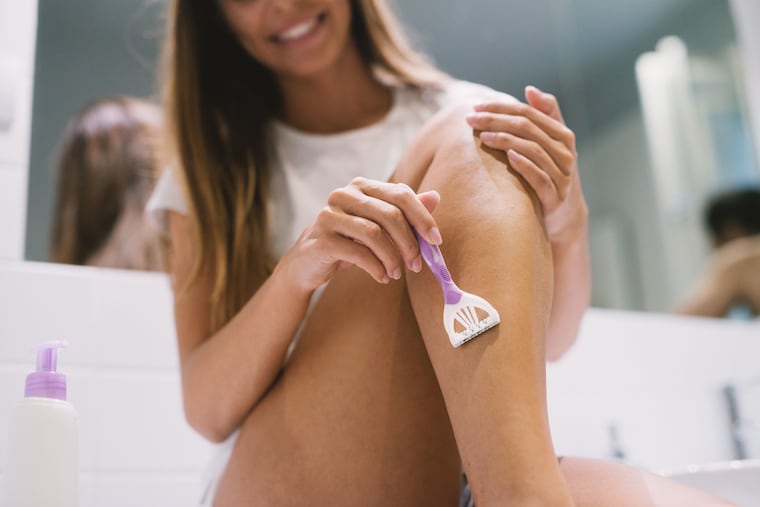You don’t need to shave there, but be careful if you do
A dermatologist says there is no hygienic or medical reason you need to remove hair; but if you must, here's the safest ways.

In my work as a dermatologist, women are constantly apologizing to me for not shaving their legs. During my regular examination, I study every aspect of the skin, ensuring that there are no concerning moles or rashes. When a woman apologizes for not removing hair, the implication is that having hair is unclean, unhygienic, distasteful, or inappropriate in some way. From a medical perspective, I don’t think it’s any of these things, yet clearly many patients feel some shame or embarrassment about it. It’s not just my being a male doctor either. My female colleagues tell me the same thing happens to them.
So, what is the truth about hair removal? Is it important? And if you choose to do it, what’s the best way?
To be absolutely clear: There is no hygienic or medical reason you need to remove hair. In fact, the opposite is true. When hair is removed, no matter how it’s done, the process may create microscopic traumas and expose you to infection. This goes for any kind of hair removal, whether it’s the legs, armpits, or pubic hair.
How about pubic hair removal specifically? In recent years, pubic hair grooming has become a widely accepted practice. But it comes with certain risks. A study in JAMA Dermatology in 2017 reported that 76.1 percent of U.S. adults groom their pubic hair (66.5 percent of men and 85.3 percent of women).
Of the groomers, 27.1 percent of women and 23.7 percent of men reported injuring themselves doing so, with the pubis the most common site in women, and the scrotum in men. Further, with even the smallest cuts in the skin, pubic hair removal may actually increase one’s risks of sexually transmitted infections (STIs). When hair is removed by shaving or waxing, it causes small injuries on the skin that allow for greater transmission of viruses, such as the human papillomavirus (HPV). In addition, there’s the fact that pubic hair prevents direct skin-to-skin contact in that area, cushioning against friction.
How about shaving legs? Can that increase your risk of infection? Well, it did for a number of women in North Carolina, as documented in a 2011 study published in the journal Clinical Infectious Diseases. Many women were developing infections from atypical mycobacteria (organisms related to tuberculosis) after getting pedicures. Did the nail clipping or trauma of pedicures cause it? It turns out that women often shave their legs prior to getting pedicures, and then when they visited the salons, they would place their recently shaved legs (fresh with microscopic injuries) into foot baths, which contained contaminated water.
Maybe I’ve convinced you now that hair removal is not medically necessary and does in fact increase your risk for problems. But, like many people, you may wish to proceed and say hair removal is necessary for your life. Many women in particular choose to remove hair as a part of our society and culture, in which hair removal is the expectation. So, what is the safest way to do it? And what are the risks?
The main options for hair removal are: shaving, plucking, waxing, and lasering.
If you shave, pluck, or wax, you must realize that hairs are only incompletely removed. These procedures merely break the hairs beneath the skin, and they will eventually regrow to the surface. If you are someone with curly hairs, you also know there’s a risk for ingrowing, which happens when a hair curves directly into the skin after emerging, or the hair grows underneath the skin.
How to minimize those pesky ingrown hairs? Avoid plucking if you can, as it can be quite traumatic. If you shave, shave with the grain. If you shave against the grain, it may cut close and feel more pleasing, but that closeness comes at the cost of increasing your risk of hairs curling under the skin surface. And in an age where razors seem to carry up 10 to 20 blades, I recommend using a device with as few blades as possible to minimize irritation.
Laser hair removal unfortunately is not cheap, but it is a safe way to potentially permanently remove hair, and many patients are very satisfied with it. It works by targeting pigment associated with hairs, and as a result, destroying the hair follicle entirely.
The most responsive patients will be those with the contrasting combination of light skin and dark hairs, since the contrast makes laser targeting easier. However, since the pigment is the target, especially in skin of color, there could be a risk of skin lightening or hypopigmentation. With time, laser hair-removal techniques have become more sophisticated, and the lightening risk is less than it once was. Still, if you have darker skin, make sure that any laser practitioner (preferably a doctor) has specific experience and comfort treating skin of color.
So, this summer, as you prepare to don your bathing suits, go ahead, if you must, and remove all the hair you deem necessary. But remember to be careful!
Jules B. Lipoff is a dermatologist and assistant professor of clinical dermatology at the Perelman School of Medicine at the University of Pennsylvania.